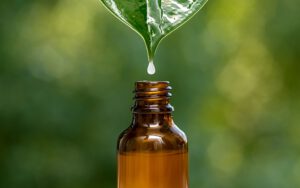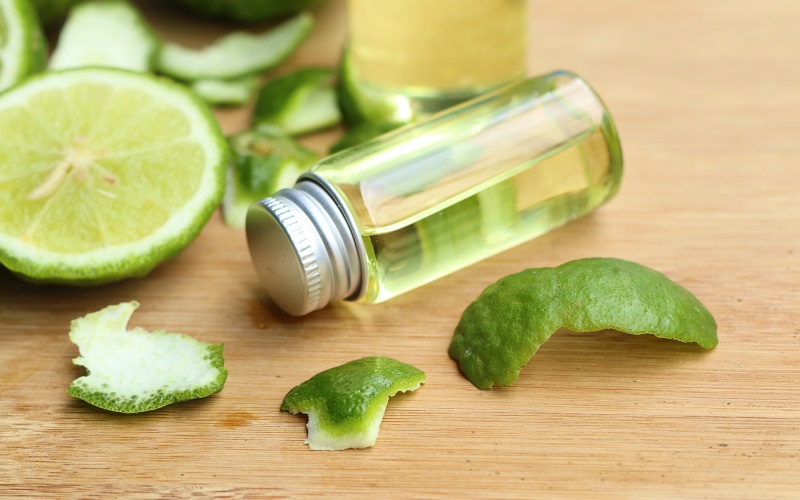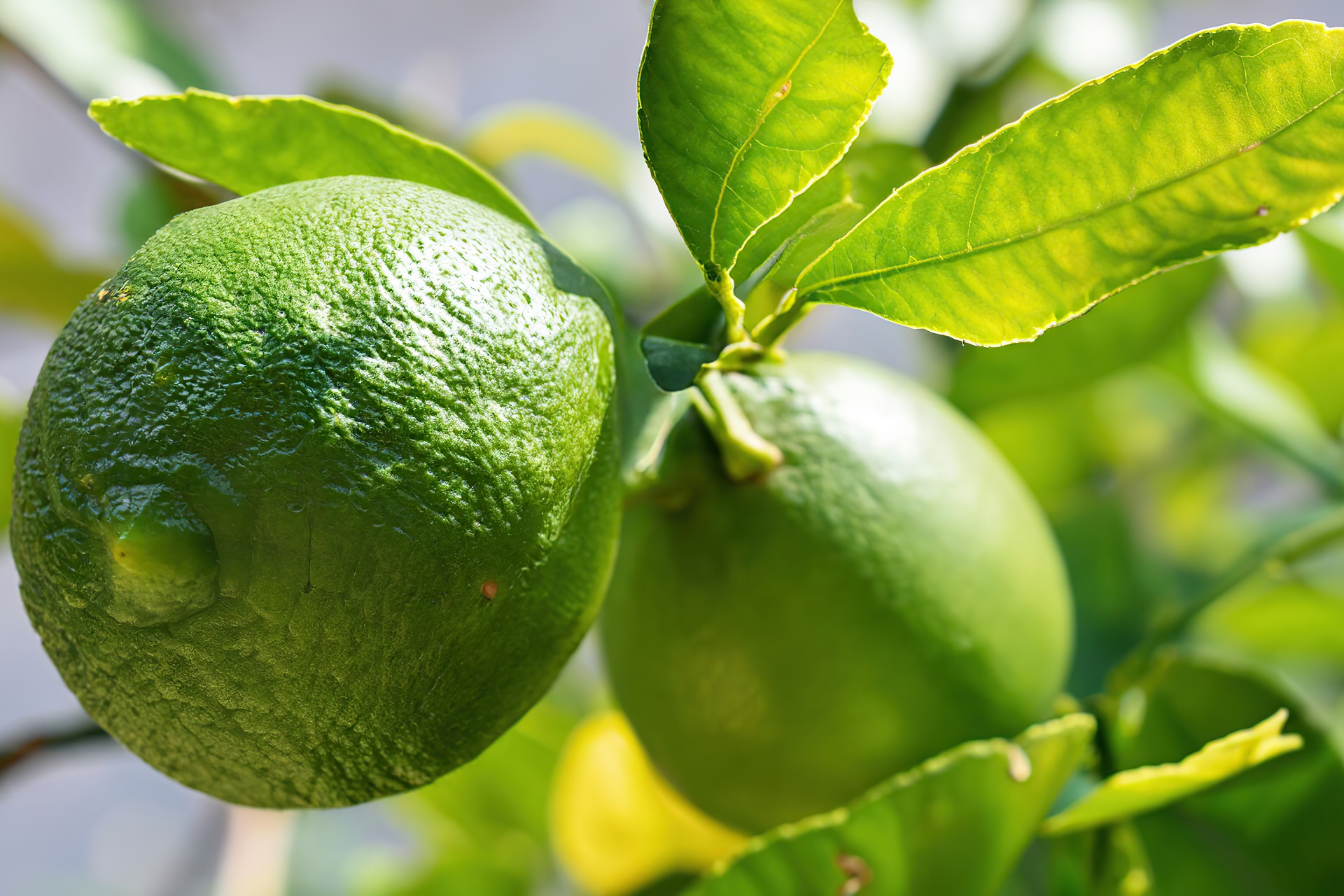The bergamot orange (Citrus bergamium) is believed to have originated in India, but is mainly grown in Italy. The tree up to 5 m tall, it has a wide crown and branches with short thorns. The flowers are small, sweetly fragrant, gathered in dense umbels, the inflorescences have a 5-petaled white corolla. The 6-8 cm long round fruit has a yellowish greenish skin and fragrant, sour flesh. The juice from the fruit is sour and bitter and is not readily drunk raw.
The fruit peel, flowers and leaves are sources of essential oils – bergamot oil used to make Earl Grey tea and neroli oil used in perfumery (e.g. in cologne). Freshly squeezed bergamot oil is a greenish-yellow or greenish-brown liquid. The scent of the oil is described as pleasant and refreshing. The scent, composition and other properties depend on the quality of the raw materials and the extraction technology. Oils from ripe fruit contain more esters than those extracted from unripe fruit: unripe fruit – 30-32%, ripe fruit – 38-42%. The main constituents of bergamot oil are linalyl L-acetate (bergamol) and L-linalool. They occur in mixtures with many other compounds, such as: D-limonene, dihydrocuminyl alcohol, nerol, bergapten, bergaptol, limethine (citroptene), bergamotine.
Bergamot oil is used to flavour foodstuffs (e.g. tea) and in the production of many perfumes, toilet soaps. Bergamot oil is used in aromatherapy and is renowned for its antidepressant properties. The oil has disinfectant and antifungal properties, and when taken orally it has an expectorant, windpipe and diuretic effect and stimulates digestion.
Bergamot oil was counterfeited with cheaper substitutes (e.g. lemon mint), which has long been a problem. The Italian government has therefore introduced controls consisting of checking and approving cleanliness. Quality control of Bergamotto flavouring oil is carried out by the Flavour and Citrus Products Control Station in Reggio di Calabria.
Earl Grey tea
It is a tea blend with bergamot oil, obtained from the bergamot orange. The bergamot oil gives the tea its characteristic intense aroma and also moderates the astringency and bitterness of the tea. Earl Grey tea has soothing and relaxing properties due to its bergamot aroma, can help maintain healthy blood sugar levels and improve immunity. The history of Earl Grey tea dates back to the 19th century and is linked to the figure of Charles Grey, British Prime Minister and aristocrat. One story says that Earl Grey received tea with bergamot oil as a gift from a Chinese tea manufacturer. It is likely that the tea may have been transported together with the bergamot fruit on ships and acquired its fragrance. Earl Grey tea with lemon and orange peel was also created in Europe.
Essential oils
The oil from the peel of the fruit can be pressed in a press, but is most often obtained by steam distillation. The main constituents of the oils obtained by hydrodistillation are volatile monoterpene hydrocarbons. The essential oils of bergamot, mandarin and orange are the subject of phytochemical studies [i, ii]. The oils were analysed using GC-MS gas chromatography. In chromatograms of oils from Chinese mandarins and oranges, 28 to 37 compounds were identified. Limonene was predominant in all essential oils; they contained a few per cent each of γ-terpinene, myrcene, but linalool was scarce. The antibacterial and antioxidant properties of citrus oils depend on their chemical composition. The antibacterial effect of the oils was tested against 5 different bacteria. All citrus oils had antioxidant properties and free radical scavenging abilities, as shown by tests with DPPH and ABTS. However, it appeared that antibacterial properties were not correlated with antioxidant properties.
Limonene
Limonene is responsible for the aroma of lemons, it is mainly found in the peel and occurs as D and L enantiomers. It is a fragrance component (detergents, air fresheners), in perfumes and cosmetics (concentration 0.005 – 2% ). In the atmosphere, limonene and other monoterpenes react with UV-derived radicals and ozone. Oxidised forms of monoterpenes contribute to aerosol formation and photochemical smog in citrus plantations. Emissions from plants are much higher in summer (0.6-1.1 µg/m3). Limonene from the air acts as a skin irritant (stronger oxidation products) in about 4% of people.
Limonene is supplied to the body with food, as it is found in citrus fruits and is used as a flavouring in food technology. Studies have shown that D-limonene may have an important role in the prevention of degenerative diseases. It has antioxidant, anti-inflammatory, cardioprotective, gastroprotective, hepatoprotective properties and influences the immune system.

Citrus flavonoids
Flavonoids (naringenin, taxifolin, eriodectol and hesperetin), which are not volatile and do not pass into the essential oil obtained by hydrodistillation, are responsible for the bitter taste of citrus peels. Once the oil has been extracted from the peel, many valuable bioactive compounds remain in the peel, so the pulp is further processed.
Juice is squeezed from the fruit pulp. The juice together with the aqueous pulp extract are spray-dried and the final product is called “powder bergamot juice (PBJ)”, or “juice powder”. Such a powdered product contains polyphenolic compounds and soluble fibre. Liquid chromatography was used to analyse its components. The HPLC-MS chromatogram identified 86 compounds, including the flavonoids hesperetin, naringenin, apigenin, eriodectol and their glycosides [iii].
Epidemiological studies show that flavonoid-rich foods prevent certain diseases, including metabolic and degenerative diseases such as atherosclerosis, cardiovascular disease, neurodegenerative diseases and cancer. In acute and chronic inflammation, the body experiences oxidative stress and an overproduction of cytokines, chemokines and inflammatory enzymes. Flavonoids have antioxidant, anti-inflammatory, neuroprotective, anticancer and antimicrobial properties [iv]. They can reduce the activity of pro-inflammatory cytokines, chemokines, as well as inflammatory enzymes such as lipoxygenases and cyclooxygenases. Chronic inflammation plays an important role in the development of cardiovascular disease. In various experimental models, including animals, quercetin, rutin, hesperidin have been shown to reduce acute and chronic inflammation. Flavonoids help maintain normal blood glucose levels and reduce the risk of diabetes-related pathologies. They have neuroprotective properties, improve neuronal function and also influence neuronal regeneration. Flavonoids have anti-cancer effects, slowing down the development of cancer. Citrus flavonoids may contribute to reducing inflammation in the lungs caused by coronavirus infection, as well as supporting post-COVID-19 recovery.
Unfortunately, despite the popularisation of the Mediterranean diet, there are too few products rich in polyphenolic compounds in the typical Polish diet. Dietitians suggest increasing the consumption of vegetables and fruits (e.g. berries) and olive oil, but dietary supplements are a way to quickly replenish the deficiencies. It is a concentrated source of valuable polyphenols in a convenient form – in a capsule.
Bergamot extract – flavonoid phytocomplex
The beneficial, health-promoting effects of bergamot extract are the result of a complex of bioactive polyphenolic compounds. They have different biological properties and act through different molecular mechanisms. The whole set of these compounds can have a synergistic effect. This not only applies to similarly acting compounds such as flavonoids, but also to other compounds from the fruit. The phytocomplex from the extract containing polyphenols and pectin is effective in supporting weight loss and improving insulin sensitivity in diabetics.
In addition to polyphenols, a valuable component of bergamot extract is soluble fibre (SDF) [v]. Its structure allows it to bind water, lipids, absorb cholesterol and glucose. Soluble fibre reduces the parameters that characterise metabolic syndrome, such as high cholesterol and high sugar levels. In studies on mice with diabetes, bergamot fibre was found to be effective in reducing glycaemia, sensitising to insulin, affecting glucose homeostasis and controlling blood lipids.
Concentrated bergamot juice extract shows numerous health benefits:
- reduction of LDL cholesterol, increase of HDL cholesterol and reduction of triglycerides;
- beneficial effects on the vascular endothelium in patients with impaired lipid and carbohydrate metabolism;
- blood sugar lowering effect and inhibition of complications in type-2 diabetes

Bergamot in food supplements
Bergamil Forte is a natural preparation containing a unique combination of bergamot fruit extract, garlic extract and vitamin C in a single capsule.
Bergamot extract (Citrus Bergamia Risso) is standardised to 40% BPF polyphenols (Bergamot-derived Polyphenolic Fraction). There are 160 mg of polyphenols in a daily serving of 400 mg of extract.
Standardised garlic extract (Allium sativum L.): there are 2 mg of allicin (including thiosulfinates, allin and gamma-glutamylcysteine) in 200 mg. Garlic is known for its antiatherosclerotic and antimicrobial effects, as well as its immune support.
The preparation also contains vitamin C: 50 mg (62.5 % RI), which also influences immunity.
Bibliography:
1. Lin X, Cao S, Sun J, Lu D, Zhong B, Chun J. The chemical compositions and antibacterial and antioxidant activities of four types of Citrus essential oils. Molecules. 2021 Jun 4;26(11):3412.
2. Fratianni F, Cozzolino A, De Feo V, et al. Polyphenols, antioxidant, antibacterial, and biofilm inhibitory activities of peel and pulp of Citrus medica L., Citrus bergamia, and Citrus medica cv. Salò cultivated in southern Italy. Molecules. 2019 Dec 13;24(24):4577.
3. Della Vedova L, Gado F, Vieira TA et al. Chemical, nutritional and biological evaluation of a sustainable and scalable complex of phytochemicals from bergamot by-products. Molecules. 2023 Mar 26;28(7):2964.
4. Al-Khayri JM, Sahana GR, Nagella P, et al. Flavonoids as potential anti-inflammatory molecules: A Review. Molecules. 2022 May 2;27(9):2901.
5. Liu H., Liang J., Liang C., et al. Physicochemical properties of dietary fiber of bergamot and its effect on diabetic mice. Front. Nutr. 2022;9:1040825.


